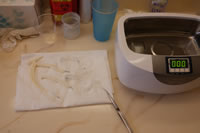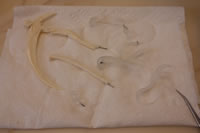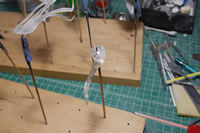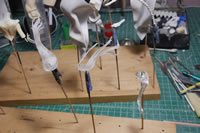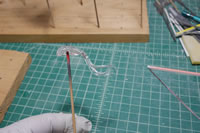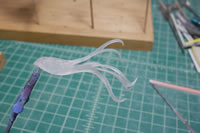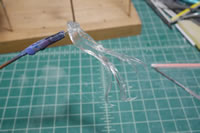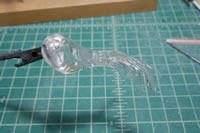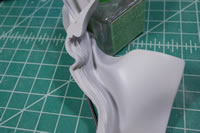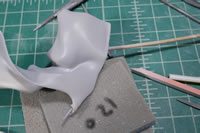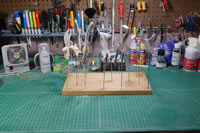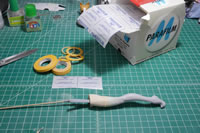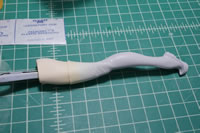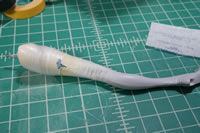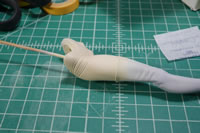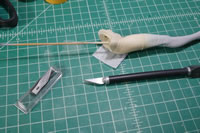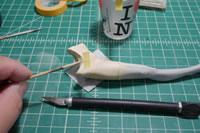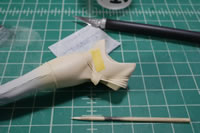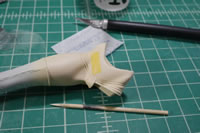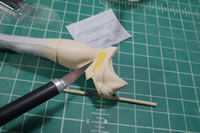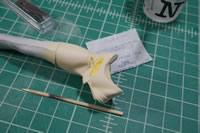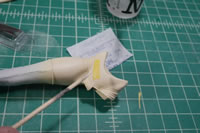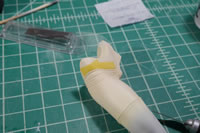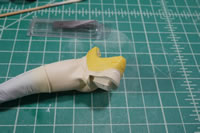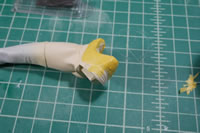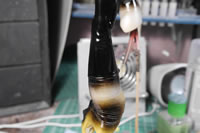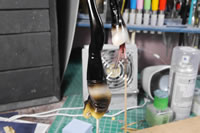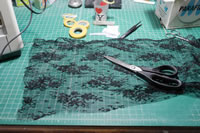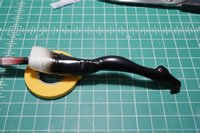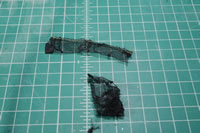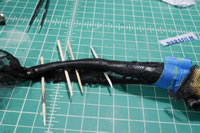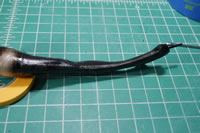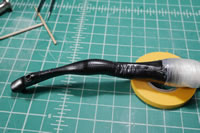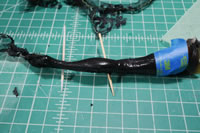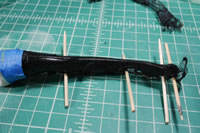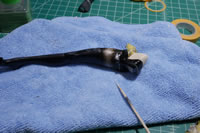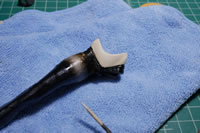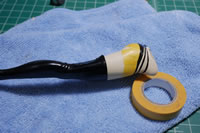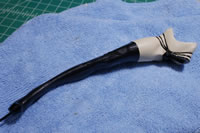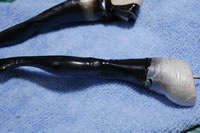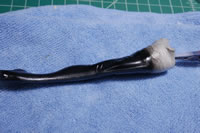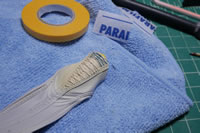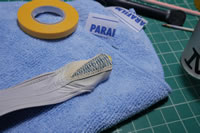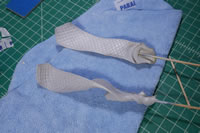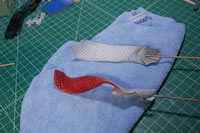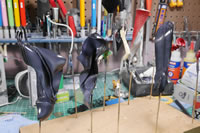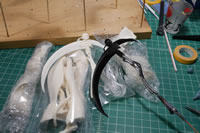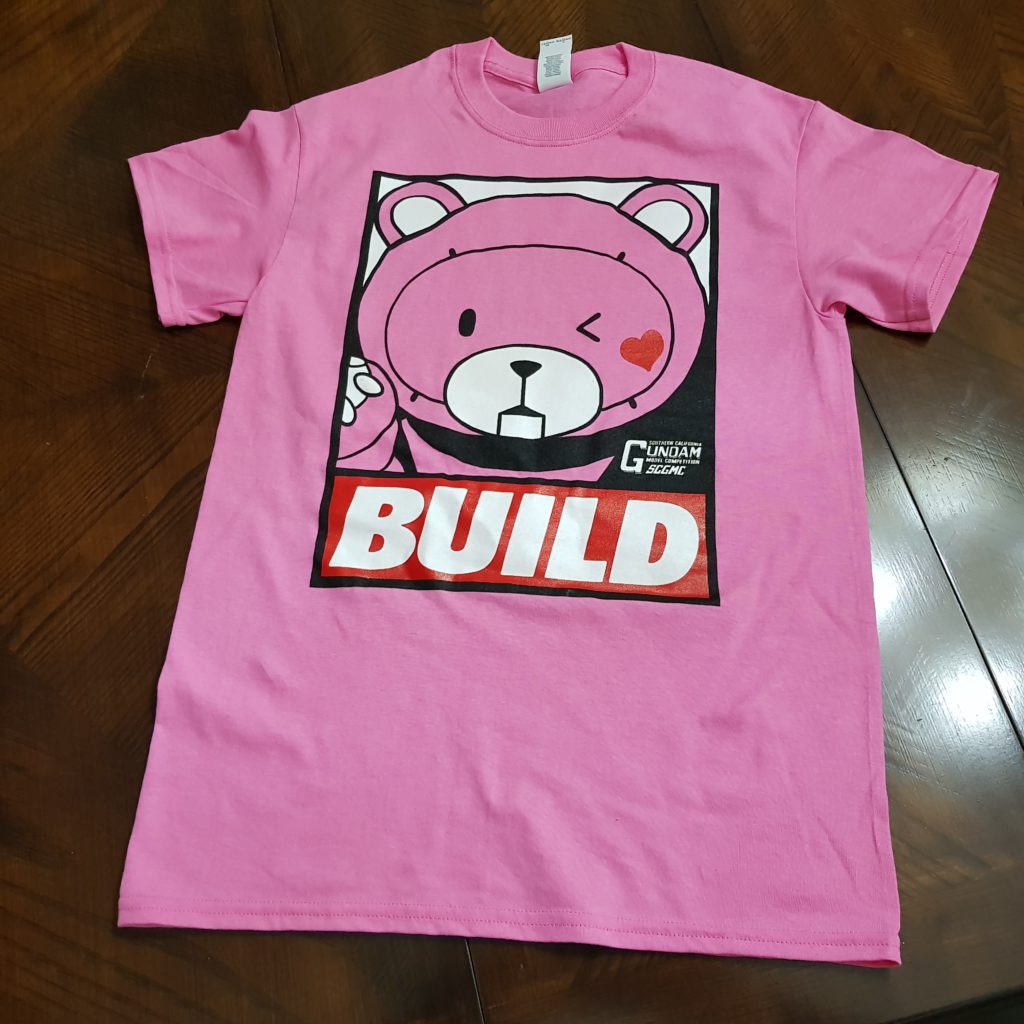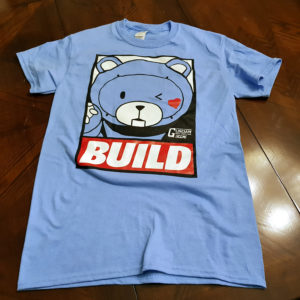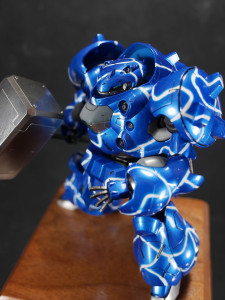Last time we left off, I was cleaning up the last bits of the kit with the scythe and the clear pieces. I have no idea why some of these pieces are clear such as the tassels since they’re going to be painted solid colors. I can understand the hair being clear, some translucent painting will come into play here. But these clear parts makes for some different approaches to clean up and filling. The resin is different, so sanding properties are slightly off in comparison to the regular resin. But once cleaned up, they go in for a soak in the industrial strength cleaner then a scrub in the ultrasonic cleaner and then dried.
After drying, the parts are ready for priming. The scythe parts are primed with regular Mr Color Surfacer Primer. The clear pieces are primed with clear gloss. The gloss fills in the tiny little scratches left over from the sanding process and when done, the part is crystal clear. There are a bunch of different methods for this such as dipping the parts into an acrylic clear medium or other products. I have a good amount of lacquer based clear gloss, so I used that.
More after the jump.
Here are a few more comparison shots of the hair before and after clear coating. It is a pretty cool effect. Too bad I’m not keeping the hair clear, it would just look too odd being clear at the area it attaches to the head. And there’s the issue of seeing the pins that hold everything together.
As I build in sections, some of the parts that have already been through the putty-sand-reprime sessions get a final check before the usual last priming session – there are always exceptions to these rules. Some of the areas have what some folks call resin boogers. Just small bits of resin on the surface that didn’t get sanded away and really show up when the parts are primed. These are pretty small and hard to see, but with close inspection, they can be pretty obvious. Those bits are sanded off and the part is primed again. Boogers gone, I can proceed to the next steps.
Once all the parts have been sanded and are ready for paint. The desk is cleaned off for the next stage of work: Painting and masking. There will be a great deal of masking for this kit. I think I’ve been spoiled by working on the Volks kits of late. Time to check back into the true reality of garage kit work.
Since one of the legs is pretty simple and the line between her exposed skin and thigh high boots is pretty straight, I used parafilm to mask off the majority of the skin. Then some detail masking for where the top of her boots do a little split is masked with some blue sticky tack.
The other leg is a different story. This will require a pointy wooden skewer, a brand new hobby knife blade and tamiya masking tape. We start off with applying the masking tape and overlapping on the curved areas. Straight areas are easy to mask, just butt the straight edges of the tape up against the straight edge. For curved surfaces, I find it easier to just lay tape down and trim it. The first step is to just lay the tape down.
Once the tape is placed, the pointy stick is used to press the tape along the cutting edge. The pointy stick ensures that the seal is good for the tape. A brand new knife blade makes sure the cut is clean. Not much pressure is needed and the blade is run along the curve edge. Pointy stick is used to lift of the excess tape and carefully pull it away. And we’ve masked off one section.
Mask, pointy stick pressing, hobby knife cut, then pointy stick lifting of paint and repeat until you’ve masked off the edge. Then finish with masking off the larger areas making sure you do not miss any overlaps of tape. Parafilm and blue sticky tack are also used here.
After an hour of masking work, it takes about 30 seconds of painting to finish the part. But no unmasking yet, there is still another layer of masking.
This next layer of masking is done with some mesh fabric that I picked up from my local fabric/craft store. I’ve done some mesh masking for gunpla in the past but I want to do something a little different this time. Starting off, I have my mesh material, the leg I want to mask, and a sewing machine to make a sock of sorts.
There is a bit of trial and error to find the best method. I created a “fitted” sock like I did for other nylon stocking projects. But the problem is that the leg has some curves and the bottom of the shoe has some protrusions so the “fitted” bit wasn’t working very well. This sock was a bit difficult to work with, but I got one leg more of less done. The other idea was to sew a bigger sock and then have the sock fit loosely over the leg then tighten the stocking at the back and just focus on painting one side first. This method was easier.
Both method were painted and the results are the pretty much same, but loose sock method was definitely easier. I couldn’t get both sides painted at the same time, but the tax on making a good fitting sock was not worth it.
I finished off the rest of the leg pieces with the mesh masking. I wanted to get some masking and lightly paint a pattern onto the front and back seams of the boot. The sculptor’s kit has something similar so I’m trying to replicate that technique with my own experience and extrapolation of what I think they did.
Pointy wooden stick is used to unmask the leg. Some care is needed to minimize paint lifting. Parafilm is a really nice product to work with since it doesn’t stick to the surface but to itself, so the chance of lifting paint is nonexistent.
And while getting ready to unmask the other leg… Oh look, just what I wanted, a big scratch in the paint… This happens. Airbrushed paint layers are very thin and if not left to properly cure, the layers are still quite delicate. The scratch could have come from the table, carelessness in masking, or just careless handling of the part. But this is part of the building process; making mistakes. Mitigating mistakes is a big part of model building. Once you accept that you will make mistakes no matter how hard to try; it just like any other process, you fix it and continue.
The leg was remasked in the areas that the masking was removed and the process to paint the leg redone. The whole leg was painted gloss black. Highlight tones were painted. The leg was left to cure for a full day before returning to the mesh masking. Then one side was painted last night. I will get to the other side tonight.
I go out of my way to not hand paint sometimes. I don’t like hand painting and will go way the hell out of the way to avoid it. Three hours were spent with a wooden pointy stick and blue sticky tack to mask off the front of the kit. The painting took 30 seconds. I know that once I unmask this area, I will need to do some touch ups with the paint brush by hand.
The sculptor’s example has the underskirts as white. I think red would look better so over the primed skirts, I sprayed white using the primer grey as shading. Once that was dry, I sprayed alclad transparent red over everything. The clear red inherits the shading from the white. I will still apply a wash down the line to help bring out more depth; but that will be done a ways from now.
A similar technique is used for the main clothing. The clothing is first painted black, then white highlights are sprayed to get some shading spots. Finally, a light misting of a dark purple made from a combination of three different sets of leftover purple paint works to blend everything together and get a purple shade over these parts.
I originally picked up this kit from Yahoo!Japan auctions after Wonfest in Feb. I didn’t know that the sculptor had planned to do a second release online to overseas customers. So when the kit went up for sale a little over a week ago, I put in another order and about 8 days later, the kit arrived. So now I have two Reapers that I can do some side by side before and after comparison.
Shameless plug
Help support SCGMC! Buy our Bearguy shirts in Pink and/or in Blue!
And for you gunpla masters, get theGunpla Elitist T-Shirt!
